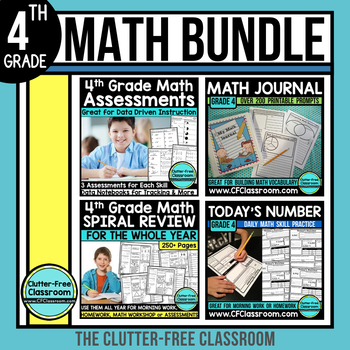4th Grade Math Assessments, Journals, Spiral Review Activities and More
- Zip

Products in this Bundle (27)
showing 1-5 of 27 products
Description
This 4th grade math bundle includes math assessments, journals, spiral review activities and more. It's a large collection of printable and digital math activities to use with your fourth graders! With this resource you'll have a go to library of resources to save you tons of time planning and prepping for your math block.
WHAT IS INCLUDED:
✔ 4th Grade Progress Monitoring Math Assessments (printable and digital)
✔ 4th Grade Math Journals (printable and digital)
✔ 4th Grade Math Spiral Review Activities (printable only)
✔ 4th Grade Number of the Day Activities (printable and digital)
✔ 4th Grade Math Quick Checks (printable and digital)
✔ 4th Grade Math Vocabulary Resources (printable and digital)
✔ 4th Grade Math Word Problems (printable and digital)
5 REASONS TEACHERS LOVE THIS RESOURCE:
► This collection of resources saves you lots of time looking for math resources. You’ll have a full library of quality math activities at your fingertips.
► It saves you lots of money because all of the resources included are at a discounted price.
► It includes a collection of math resources that can be used to supplement or complement your school district’s curriculum program.
► It is standards-based, so you can feel confident knowing that your students are learning the most important concepts and skills for your grade level.
► It includes both printable and digital resources so your students can access them in class and at home.
VISIT OUR LET'S GET CONNECTED PAGE TO CHOOSE FROM . . .
◼️THE EMAIL CLUB → weekly freebies
◼️FACEBOOK GROUP → a supportive community of elementary teachers
◼️THE TPT STORE → new resources 50% off
◼️THE BLOG → teaching tips and ideas
◼️INSTAGRAM → a look behind the scenes


